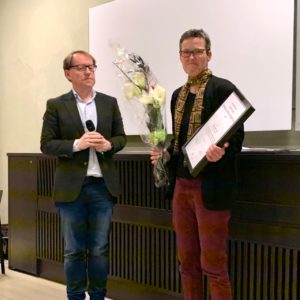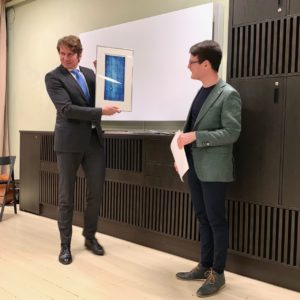[AVLYST PGA. SYKDOM!]
Forskargruppe i nordisk språk inviterer til seminar:
30. jan, kl. 13:30-15:00
HF-bygget, rom 435
«den raude rase» og «negerfolk»: Om kontroversielle ord og nemningar i standardordbøkene
Innleggshaldarar: Gunn Inger Lyse og Terje Svardal
To språkforskere ved UiB mottok utmerkelser 12. desember 2020. Vadim Kimmelman (førsteamanuensis i lingvistikk) fikk prisen for unge forskere ifm. sin forskning på tegnspråk. Ingunn Lunde (professor i russisk) fikk status som fremragende underviser. 
Chiara Calderone (Ca’ Foscari University of Venice) will give a guest lecture: Could you retrieve it? sentence topics and communicative strategies in Italian Sign Language (Lingua dei Segni Italiana)
Time: May 10, 2019 at 10:15
Place: HF-bygget, seminarrom 301
Abstract: The current research investigates how old information (topic) is managed among Italian Sign Language users. Particularly, it addresses the prosodic and syntactic strategies adopted by signers in signalling shared knowledge in spontaneous communicative exchanges. The findings in LIS have shown that three types of sentence topic are distinguishable: aboutness topics, scene-setting topics and contrastive topics. All the three topic types under analysis display specific non-manual markers, which fulfil both prosodic and pragmatic functions. Focusing on aboutness topics, the retrievability of shared information (which is assumed by the signer) may affect the morpho-syntactic realizations of such a topic type. In line with other research on spoken languages (Ariel 1988, Givón 1983), the more accessible a referent is, the less phonological material is required to retrieve it. LIS seems to organize information according to the same criteria, but as a visual-gestural language, it also displays some language-specific strategies. In a scale from less accessible to more accessible information, the following referential hierarchy seems to hold true in LIS: DPs > pronouns > null (with predicate classifiers) > null (with agreement verbs) > null (with non-agreement verbs).
Vadim Kimmelman (UiB) will give a lecture: Why you should be interested in sign languages
Time: Friday April 26, 2019 at 13:30
Place: HF-bygget, rom 372
Abstract: Sign languages have been studied by linguists for the past 50 years. However, probably most of typological and theoretical research in linguistics still ignores sign languages, which is a big mistake. I will discuss some of the topics I worked on to show why sign language data is necessary. I will focus on two theoretical fields (information structure and argument structure), and on two methodological domains (corpora and acceptability judgments).
CLARIN has published an extensive interview with Helge Dyvik about his involvement in INESS.
Paul Meurer (UiB) vil gi et seminar om følgende tema: The Abkhaz National Corpus project
Time: Friday March 29, 2019 at 10:15
Venue: HF building, room 400
The Abkhaz National Corpus is a comprehensive and open, grammatically annotated text corpus comprising more than 10 million words. It was built in a joint effort with partners in Abkazia, Georgia and Germany, where Paul Meurer was in charge of the linguistic and computational work in the project. The corpus is hosted at the CLARINO Bergen Centre.
Abkhaz is a lesser-resourced language; prior to this work virtually no computational resources for the language were available. As a member of the West-Caucasian language family, which is characterized by an extremely rich, polysynthetic morphological structure, Abkhaz poses serious challenges to morphosyntactic analysis, the main problem being the high degree of homonymy and morphological ambiguity.
In the talk it will be shown how these challenges can be met, where the main focus will be on the construction of the finite-state morphological analyzer, including the implementation of word stress, and on strategies to cope with ambiguity. The talk will conclude with a demonstration of the corpus as a tool for linguists and for learners of the language.
Helge Dyvik (UiB) vil gi et seminar om følgende tema: Er vi fokusert eller fokuserte? Partisippenes indre kamp i bokmål.
Tid: Fredag 22. mars 2019 kl. 13:15
Sted: HF-bygget, rom 217
På nynorsk lærer vi at det heter Korleis var dei plasserte?; To demonstrantar er drepne; Bilane var skjulte bak trea, mens det på bokmål heter Hvordan var de plassert?; To demonstranter er drept; Bilene var skjult bak trærne. Den forenklede regelen er at perfektum partisipp som predikativ eller hovedverb etter være og enkelte andre verb samsvarsbøyes med subjektet i nynorsk, men ikke i bokmål. Det er likevel lett å finne unntak i tekster på begge målformer. I nynorsk (som ikke er hovedtema for dette innlegget) er samsvarsbøyningen i stor grad offisielt valgfri. For bokmål er det vanlig å si at når partisippet har etablert seg som et adjektiv, kan det samsvarsbøyes også der, som andre adjektiver (eks.: Pattedyr er mer avanserte enn vi har trodd). Spørsmålet er da når det er rimelig å si at partisippet er å betrakte som et adjektiv. I hvilken grad kan konsistente kriterier for dette abstraheres fra faktisk språkbruk i tekstene?
I dette innlegget vil jeg se nærmere på dette spørsmålet med utgangspunkt i materiale fra trebanken NorGramBank, der det kan søkes etter eksempler i utførlig syntaktisk analysert bokmålstekst på ca. 60 mill. ord. Vi skal også se på hvordan de relevante konstruksjonene analyseres i den grammatikken som er brukt i den automatiske analysen av tekstene (NorGram). NorGramBank forvaltes gjennom INESS, en del av CLARINO.
|
|

